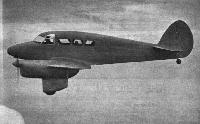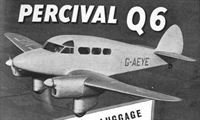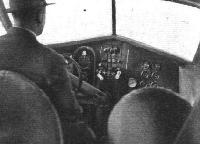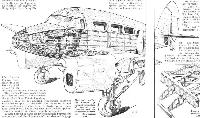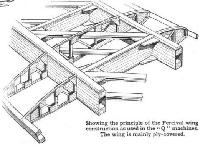
Percival Q.6 Petrel
Первым двухмоторным самолетом Эдгара Персиваля был Percival Type Q, проектировавшийся в двух вариантах - легкого четырехместного транспортного Q.4 с двумя моторами de Havilland Gipsy Major и шестиместного Q.6 с моторами Gipsy Six. Построили только второй вариант. Прототип Q.6 выполнил первый полет 14 сентября 1937 года. Это был низкоплан с крылом консольного типа и неубираемым шасси с хвостовой опорой. Серийное производство началось в 1938 году; построено 27 самолетов, включая четыре с убираемым шасси. Два самолета закупило правительство Египта, несколько машин использовались как связные британскими ВВС под обозначением Q.6 Petrel. В мае 1940 года девять самолетов Q.6 с британской регистрацией было реквизировано для ВВС и ВМС, еще два - изъяты для военных нужд в Гелиополисе, Египет. После войны самолеты из Гелиополиса и три машины британских ВВС снова получили гражданскую регистрацию.
ТАКТИКО-ТЕХНИЧЕСКИЕ ХАРАКТЕРИСТИКИ
Percival Q.6 Petrel
Тип: шестиместный связной самолет
Силовая установка: два мотора de Havilland Gipsy Six мощностью по 205 л. с. (153 кВт)
Летные характеристики: максимальная скорость 314 км/ч; практический потолок 6400 м; дальность 1207 км
Масса: пустого 1588 кг; максимальная взлетная 2495 кг
Размеры: размах крыла 14,22 м; длина 9,83 м; высота 2,97 м; площадь крыла 25,83 м2
Описание:
- Percival Q.6 Petrel
- Flight, December 1937
THE PERCIVAL "TWINS" - Flight, October 1938
British Commercial Aircraft - Flight, September 1939
To-day's Light Aeroplanes - Flight, November 1939
Britain's Civil Aircraft
Фотографии
-
Flight 1937-12 / Flight
Quite delightfully clean, even with a fixed undercarriage, the Q6 with retractable wheels will be uncommonly attractive.
-
Jane's All the World Aircraft 1938 / 03 - All the world's aeroplanes
Two views of the Percival Q-6 Six/seven-seat Cabin Monoplane.
-
Flight 1937-12 / Flight
KEEPING US ON THE MAP: The dearth of truly modern British commercial aircraft types is met to no unimportant extent by the introduction of the Percival Q4 and Q6 twin-engined monoplanes. Apart from being attractive propositions for the private owner the newcomers should be useful for charter and feeder work. This attractive view shows the prototype Q6 (Gipsy Six IIs), with fixed undercarriage, flying near Luton Aerodrome the other day.
-
Flight 1937-12 / Flight
The twin-engined six-seater Percival monoplane, the Q.6 with D.H. Gipsy Six II engines
-
Flight 1937-12 / Flight
Despite the comparative roominess of the cabin the new Percival is of attractive external form. The efficient windscreen shape is discernible here.
-
Flight 1938-03 / Flight Advertisements
Регистрационный номер: G-AEYE [8] -
Aeroplane Monthly 1983-02 / J.Silvester - Percival Aircraft 1933-1954 (2)
Регистрационный номер: G-AEYE [8] G-AEYE, the prototype Q.6 flying near Luton in 1937. It made its first flight from there on September 14, 1937 in the hands of its designer.
-
Air Pictorial 1956-06 / Air Pictorial's photo-review
Регистрационный номер: G-AEYE [8] One of three remaining Percival Q-6s on the British Register, G-AEYE (c/n. Q.20), was built in 1937. May be seen at Croydon Airport. Has white top decking.
-
Aeroplane Monthly 1983-02 / J.Silvester - Percival Aircraft 1933-1954 (2)
Регистрационный номер: G-AEYE [8] The first and last. In the foreground, G-AFAA, the last Mew Gull built; in the background the prototype Q.6 G-AEYE, seen at Hayes in 1939.
Другие самолёты на фотографии: Percival Mew Gull - Великобритания - 1934
-
Aeroplane Monthly 1979-10 / Croydon /Gone but not forgotten/ (5)
Percival Q.6 and D.H. Dove on the Croydon apron in the mid 1950s
Другие самолёты на фотографии: De Havilland Dove / D.H.104 - Великобритания - 1945
-
Aeroplane Monthly 1988-05 / Personal album. Civil
Регистрационный номер: G-AFFD [8] Percival Q.6 G-AFFD at Lympne in 1938; note the 601 Sqn flying sword emblem on the fin. Sir Philip Sassoon's grey and silver Q.6 was the first production example, built during the winter of 1937-38 and delivered to Sir Philip on March 2, 1938. In April 1940 'FD was impressed into RAF service as X9407; after the war it was restored to the register under the ownership of the Yorkshire Aeroplane Club, and was based at Sherburn-in-Elmet. In 1956 the Q.6 was moved to Redhill where it became an instructional airframe with the College of Aeronautical Engineering. It is now being restored to fly again.
-
Aeroplane Monthly 1985-07 / Personal album
Регистрационный номер: G-AFIX This visiting Percival Q.6, G-AFIX, was painted in faded PR blue and was covered in numerous doped patches. It crashed at Bromhall in May 1949.
-
Flight 1938-04 / Flight
Регистрационный номер: G-AEYE [8], G-AFFD [8], YI-ROH [6] A well-arranged trio of Percival Q.6 monoplanes (two Gipsy Six II). This type is likely to make its mark as a small commercial type.
-
Flight 1938-04 / Flight
Регистрационный номер: G-AEYE [8], G-AFFD [8], YI-ROH [6] CIVIL FORMATION: A pleasant impression of three of the new Percival Q.6 monoplanes, specially “posed” by their pilots for Flight's photographer. The nearest, which is painted flame and yellow, is for King Ghazi; next is the demonstrator; and third is Sir Philip Sassoon's. The Q.6 is a feeder-line, charter or luxury private-owner type, and is fitted with the Gipsy Six Series II.
-
Flight 1938-07 / Flight Advertisements
Регистрационный номер: G-AEYE [8], G-AFFD [8], YI-ROH [6] -
Aeroplane Monthly 1983-02 / J.Silvester - Percival Aircraft 1933-1954 (2)
Регистрационный номер: G-AEYE [8], G-AFFD [8], YI-ROH [6] This trio of Q.6s includes the prototype, G-AEYE, leading the formation, G-AFFD and YI-ROH.
-
Aeroplane Monthly 1983-02 / J.Silvester - Percival Aircraft 1933-1954 (2)
Регистрационный номер: YI-ROH [6] Q.6 YI-ROH, Bird of Eden, was sold to King Ghazi of Iraq.
-
Jane's All the World Aircraft 1938 / 03 - All the world's aeroplanes
Регистрационный номер: YI-ROH [6] The Percival Q-6 Twin-engined Cabin Monoplane (two 200 h.p. D.H. "Gipsy-Six" engines).
-
Flight 1939-04 / Flight
Регистрационный номер: VH-ABL [4] In its latest retractable-uncarriage form - the Percival Q.6, which has a maximum speed of more than 200 m.p.h. on the Gipsy Six engines.
-
Aeroplane Monthly 1983-02 / J.Silvester - Percival Aircraft 1933-1954 (2)
Регистрационный номер: VH-ABL [4] First Q.6 fitted with a retractable undercarriage was VH-ABL. It was not delivered to Australia and instead was registered G-AFMT and sold to Vickers Armstrongs Ltd.
-
Flight 1939-11 / Flight
Регистрационный номер: VH-ABL [4] A Percival Q6 light transport as fitted with a retractable undercarriage. The engines are Series II Gipsy Sixes.
-
Flight 1939-04 / Flight
TUCKED UP: The Percival Q6 in its latest form, with undercarriage retracted. This machine is one of two for Australia.
-
Flight 1939-09 / Flight
Регистрационный номер: VH-ABL [4] The Percival Q.6 in retractable undercarriage form. This particular machine was one for Australia.
-
Aeroplane Monthly 1983-02 / J.Silvester - Percival Aircraft 1933-1954 (2)
Регистрационный номер: VH-ABY Four Percival Q.6s had retractable undercarriages. One was VH-ABY, seen here during a high speed flypast at Luton.
-
Flight 1940-12 / Flight
The Percival Q.6 (two Gipsy Six) was originally a light transport but is now used by the R.A.F.
-
Flight 1938-10 / Flight
Регистрационный номер: LY-SOA [4], LY-SOB [4] FOR LITHUANIAN SERVICES: As related above, these two radio-equipped Percival Q.6s were recently flown out to Kaunas for use on Lithuania’s first airline - an internal one between the base and Palanga.
-
Aviation Historian 39 / G.Endres - Baltic Triangles
Регистрационный номер: LY-SOA [4], LY-SOB [4] In the summer of 1938 British manufacturer Percival received an order for two of its handsome Q.6 twin-engined transports from the newly established Lietuvos Oro Linijos (Lithuanian Air Lines), which had rejected some 14 other types of aircraft for its services. The pair were delivered to Lithuania during September 1-9, 1938.
-
Aviation Historian 39 / G.Endres - Baltic Triangles
Регистрационный номер: LY-SOA [4], LY-SOB [4] Percival Q.6s LY-SOA and LY-SOB were the only two aircraft operated by Lietuvos Oro Linijos. When Lithuania was annexed by the Soviet Union in June 1940, both were allocated to Aeroflot’s Baltic Directorate as CCCP-C124 and CCCP-C125. One went to Moscow and the other was captured by the Germans in July 1941.
-
Авиация и Космонавтика 2018-02 / В.Морозов - Авиация Литвы: 1919-2018гг. (2)
Регистрационный номер: LY-SOA [4], LY-SOB [4] Литовские пассажирские самолеты Персиваль Q-6L (LY-SOA и LY-SOB), которые с 1938 г. летали на авиалинии Каунас-Паланга. На фото видно, что присвоенные самолетам имена «Дарюс» и «Гиренас» на бортах машин не писались. Фото 1938-1939 гг.
-
Aeroplane Monthly 1980-02 / Gravesend /Gone but not forgotten/ (7)
Регистрационный номер: F-AQOK Percival Q-6 F-AQOK, later G-AFVC, shortly before the war.
-
Aeroplane Monthly 1983-02 / J.Silvester - Percival Aircraft 1933-1954 (2)
Регистрационный номер: P5636 One of seven Q.6s built to Air Ministry Contract was P5636. Other civil Q.6s were impressed into RAF service on the outbreak of the war.
-
Мировая Авиация 212
Регистрационный номер: P5639 Percival Q.6 произвел положительное впечатление на британских военных. Почти все построенные Q.6 поступили в ВВС и ВМС Великобритании, в годы войны их использовали в качестве связных.
-
Aeroplane Monthly 1983-02 / J.Silvester - Percival Aircraft 1933-1954 (2)
The Q.6 production line at Luton in 1937.
-
Aeroplane Monthly 1980-02 / News Spotlight
Регистрационный номер: G-AFFD [8] The sole surviving Percival Q6, G-AFFD, is seen during preparation for its departure from Duxford, where it had lain in the open for some time. Its present owners, the Midland Aircraft Museum, arranged alternative accommodation for the aeroplane on a Warwickshire farm pending a decision on its future, and the entire removal operation was made possible by the generosity of Coles Cranes Ltd.
-
Aeroplane Monthly 1980-02 / News Spotlight
Регистрационный номер: G-AFFD [8] -
Aeroplane Monthly 1983-05 / P.Jarrett - Grapevine
Регистрационный номер: G-AFFD [8] The new wings for Percival Q6 G-AFFD, built by Speedwell Sailplanes of Marple, Cheshire, now await restoration of the fuselage to which they will be mated.
-
Aeroplane Monthly 1983-02 / J.Silvester - Percival Aircraft 1933-1954 (2)
The Q.6's cockpit, fully equipped for blind flying and featuring a swing-over control column.
-
Flight 1937-12 / Flight
Captain Edgar Percival at the controls of the prototype Q6. It will be gathered that there has been no stinting of elbow room in the cockpit, nor, for that matter, in the cabin.
-
Flight 1938-04 / Flight
ROYAL EQUIPMENT: Inside King Ghazi’s Percival Q.6. On the right is the very complete Marconi two-way radio equipment with D F (or homing) loop, the graduated control wheel of which can be seen at the top of the picture. Interesting features of the Q.6 dashboard are the trimming cranks on the throttle bank, the D.H. constant-speed airscrew controls at the top of the dash to the right of the throttles, and the vacuum-operated flap control below the airscrew levers. All the six seats have Irvin seat-type parachutes.
-
Air-Britain Archive 1984-01
Регистрационный номер: G-AHOM Already a target for souvenir hunters when this shot was taken on 19.4.62, the Q.6 G-AHOM gradually decayed at Thruxton after being wfu in 1961
-
Jane's All the World Aircraft 1938 / 03 - All the world's aeroplanes
A sectional drawing of the Percival Q-6 monoplane.
-
Aeroplane Monthly 1983-02 / J.Silvester - Percival Aircraft 1933-1954 (2)
This cutaway drawing of the Q.6 appeared in The Aeroplane of December 22, 1937.
-
Flight 1939-04 / Flight
The Percival Q.6 cabin as laid out for airline work. A toilet compartment may be arranged in place of the seventh seat.
-
Flight 1937-12 / Flight
The "backbone" of the Percival Q6 showing the box type of fuselage construction and the framework beneath the ply-covered nose.
-
Flight 1937-12 / Flight
Showing the principle of the Percival wing construction as used in the "Q" machines. The wing is mainly ply-covered.
-
Jane's All the World Aircraft 1938 / 03 - All the world's aeroplanes
The Percival Q-6 Monoplane.
- Фотографии



